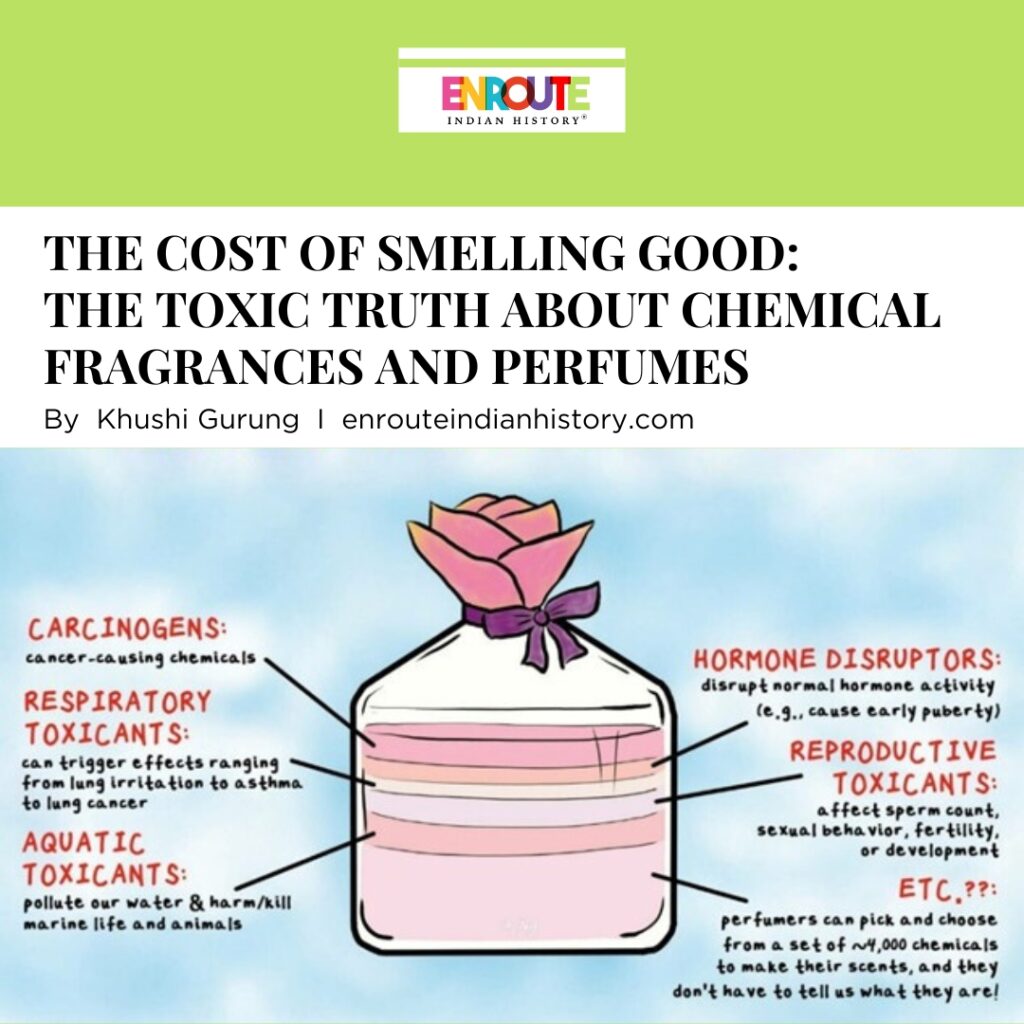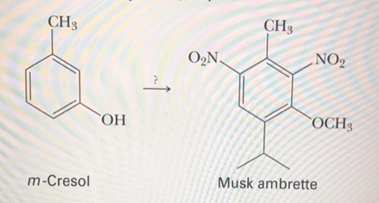The Cost of Smelling Good: The Toxic Truth about Chemical Fragrances and Perfumes
- enrouteI
- July 26, 2024


Source: Women’s Wear Daily, Some of the branded perfumes and fragrances.
Imagine walking into a room and instantly transforming the atmosphere with just a few spritzes of fragrance. Perfumes have long been our invisible companions, enhancing our moods and leaving lasting impressions. But have you ever paused to consider what is in that alluring bottle? As we dive into the world of perfumes, we uncover a fascinating contrast: the age-old tradition of natural scents versus the modern allure of chemical perfumes and fragrances. While the former draws on nature’s bounty, the latter often relies on synthetic creations that promise longevity and boldness. Perfumes and fragrances have been an integral part of human culture for thousands of years, serving as symbols of status, beauty, and spiritual significance. Fragrance on one hand is a combination of organic compounds that create a distinct smell while perfume is a complex mixture of fragrant essential oils, aroma compounds, solvents, and fixatives used to produce a pleasant and appealing scent, hence perfumes are made from fragrances. The word perfume is used today to describe scented mixtures and is derived from the Latin word, “per fumus,” meaning ‘through smoke’. In today’s world, perfume serves various functions beyond merely providing a pleasant fragrance. It plays a significant role in personal grooming and hygiene, enhancing an individual’s self-confidence and social presence too. But in today’s world modern perfumery has seen the advent of synthetic compounds that replicate natural scents and create entirely new olfactory experiences. To look at the disadvantages of chemical perfumes let us look into its history first.
The genesis of Indian perfumery traces back to antiquity, perhaps even preceding recorded history. According to a 1975 report, archaeologist Dr Paolo Rovesti found a terracotta distillation apparatus in the Indus valley together with oil containers made of the same material, carbon dated to 3000 BCE suggesting a sophisticated understanding of fragrance extraction, where natural ingredients like flowers, herbs, and resins were used to create fragrant oils and balms. But the tradition of perfumery dates back to the Vedic period (1500-500 BCE), with the use of aromatic substances in religious rituals and daily life. Ancient Indian texts, such as the Brihatsamhita of Varahamihira, dating back to 500 AD mentions different types of perfumed articles, their natural sources, method of preparation, etc., have been treated in this text under the heading “Gandhayukti”, a term which stands for the art and science of perfumery.
According to the International Journal of Creative Research Thoughts’ ‘research paper on Indian History of Perfume, Its Evidences and Evolution from Different Era, the art and science behind the perfume and scented articles is not new to India, and that perfumery had developed as a science in ancient India and our country has contributed nothing less to this branch of science which now has reached a very advanced stage.

Source: Hindustan Times, A gouache painting of Indian perfume sellers from 1840.
Now these essential oils were termed as “itr,” or “attar” flourished under the medieval period, particularly during the Mughal era. According to legend, the Mughal kings who controlled India in the 16th century brought the custom of attar production in India due to their connections to the Persian culture. Attar was generally used by the royal people and the rich nobility in Medieval India. The modern perfume industry began to take shape in the 19th century with the advent of synthetic chemistry. The discovery of new compounds and advancements in chemical synthesis allowed perfumers to create a vast array of scents that were previously impossible with natural ingredients alone. Chemical perfumes offered several advantages, including lower production costs, enhanced scent stability, and the ability to mass-produce fragrances with consistent quality. This period marked the transition from traditional, natural perfumery to the production of chemical fragrances.
The Toxic Truth of Chemical Perfumes
In the modern era, the use of known toxic substances in fragrances is common and Industries have reports of using more than 3,000 chemicals. According to some consumer safety organisations and many researchers, industries use toxic chemical substances in perfumes and fragrances primarily for cost-effectiveness, consistency, and performance. Today, on average, over 95% of perfume formulations are composed of harmful synthetic chemicals and they often contain carcinogenic chemicals, respiratory irritants, neurotoxins, narcotics, hormone sensitizers, and many more. Perhaps the reason fragrance companies got away with selling toxic products for so long is that they are not legally required to list their ingredients on the labels. Regulations have made it legal to keep their ingredients undisclosed by simply disgusting them under the term “fragrance”. In 1986, the National Academy of Sciences tested commonly used fragrances for neurotoxicity; however, the results have still yet to be released. The good news is that many other tests have been done. In fact, in 1991 the Environmental Protection Agency tested conventional, synthetic perfumes and found a long list of toxic chemical ingredients, including acetone, benzaldehyde, benzyl acetate, benzyl alcohol, camphor, ethanol, ethyl acetate, limonene, linalool, methylene chloride as well as phthalates, stearates, and parabens. Below is the list of toxic chemicals that are often used in synthetic perfumes:

Source: CSC, a picture of a bottle of perfume showing harmful toxic chemicals present in it.
- Phthalates are a group of chemicals used to make plastics more flexible and to act as solvents in many consumer products, including perfumes. They are primarily used in fragrances to help the scent last longer. A 2021 study published in Environmental Health Perspectives investigated the presence of phthalates in personal care products, including perfumes. The research highlighted that phthalate, such as diethyl phthalate (DEP), are commonly used in fragrances and are known endocrine disruptors.

Source: Chegg, The chemical formula for synthetic musk, one of the most used chemicals in synthetic perfume.
2. Synthetic musks, including polycyclic musks and nitro musks, are used in perfumes to provide a long-lasting scent. Studies have shown that synthetic musks can disrupt hormone systems and have been found in human breast milk, body fat, and even umbilical cords.
3.Parabens are used as preservatives. It prevents the growth of bacteria and mold. They can mimic estrogen and disrupt hormone function, potentially leading to breast cancer and reproductive toxicity.
4.Benzyl Alcohol are used as a solvent and preservative. It can cause allergic reactions and is irritating to the skin and respiratory tract.
5.Formaldehyde on the other hand, is used as a preservative and to produce certain fragrance ingredients. Formaldehyde is a known carcinogen and can cause respiratory issues and skin irritation.

Source: The Hans India, A picture illustrating the dangers in a single spray.
Exposure to perfumes which contain toxic chemicals in it may cause a wide range of varying adverse effects on the human body ranging from migraine headaches to respiratory difficulties to skin irritations. Headaches are a common problem often found associated with chemical perfumes (mainly due to
volatile organic compounds (VOCs), especially on direct inhalation or exposure to perfume mixture. In addition, an intense headache may lead to nausea, vomiting, and dizziness as well. Birth defects and hormonal disruptions are also a cause of concern due to the toxic chemicals like phthalates present in these perfumes. Foetal exposure to this class of chemicals has been linked to various birth defects such as autism, neurological disorders, and symptoms of attention deficit hyperactivity disorder (ADHD). The man-made chemicals used in perfumes are volatile and are most often breathed in to feel the pleasant smells. This may lead to various issues in the respiratory system ranging from infections of the lungs to damaging lung cells. Environmental Working Group (EWG) researchers found more than 75% of products with the ingredient “fragrance” contained phthalates (THAL ates) which have been shown to reduce sperm counts, linked to thyroid and reproductive disorders, liver and breast cancer. These may be listed as DBP (di-n-butyl phthalate) or DEP (diethyl phthalate) on the ingredients label. Ingredients like benzyl alcohol and synthetic musks can cause contact dermatitis and other allergic reactions. These chemicals may lead to skin redness, itching, and rashes. Prolonged exposure can exacerbate these symptoms and lead to more severe allergic reactions. Several chemicals in perfumes, including formaldehyde and certain synthetic musks, have been linked to an increased risk of cancer and other long term health risk. Formaldehyde is a known carcinogen, and some synthetic musks are suspected of being potential carcinogens due to their ability to persist in the body and environment.
Case Studies

Source: Allure, A picture showing the infamous Victoria’s Secret perfume “Bombshell” being portrayed as a mosquito repellent.
We all must have known about the very infamous Victoria’s Secret brand known mostly for its Perfumes and body mist. There perfumes are usually known for its high quality and long-lasting smell. But have you ever wondered that this branded perfumery company works dually. According to an article posted by Fionna McDonald, it said that, “Scientists have shown that popular Victoria’s Secret perfume, Bombshell, can actually repel mosquitoes effectively for up to 2 hours.” In 2015, researchers Stacy Rodriguez, Immo Hansen, and their team tested various substances for their effectiveness in repelling mosquitoes. The study included 10 different products: 2 commercial insect repellents, 1 vitamin B1-based mosquito repellent patch, and 7 fragrances, including Victoria’s Secret “Bombshell”. The effectiveness of “Bombshell” was compared with DEET-based repellents, as well as other perfumes and the control (untreated hand). The study found that Victoria’s Secret “Bombshell” significantly reduced mosquito landings for up to 2 hours after application. It performed better than some commercial insect repellents and was particularly effective during the initial period after application.
Another major type of fragrance which is toxic is the Axe Body Spray, a popular fragrance product by Unilever, has been a staple in the grooming routines of many young men. However, concerns have emerged regarding the presence of toxic chemicals in its formulation. Various studies and consumer advocacy groups have highlighted the potential health risks associated with some of the ingredients used in Axe Body Spray. One of the primary concerns is the presence of phthalates, a group of chemicals used to stabilize fragrances and increase their longevity. Phthalates have been linked to hormonal disruptions, reproductive issues, developmental problems, and headaches. According to a women named Rosa Silk, she had posted her story of her son on WVF, a women-based consumer advocacy group, who suffered from a chemical reaction caused by this body spray.
“At first it was headaches, but he soon started getting hives on his face and arms and had trouble breathing. One dreadful day, he went into anaphylactic shock. We were rudely awakened to the fact that there was something seriously wrong” says Rosa in WVF article.
Axe Body Spray, like many commercial fragrances, contains phthalates, parabens, and synthetic musk’s, which are known to disrupt endocrine function and cause allergic reactions. But what can be done about toxic fragrance ingredients in cosmetics? In 2021, U.S. Representatives Jan Schakowsky and Doris Matsui introduced the Cosmetic Fragrance and Flavour Ingredient Right to Know Act, which would require companies to disclose fragrance and flavour ingredients that are harmful to human health or the environment on their product labels and websites. Fragrance ingredient disclosure will allow consumers to make safer and more informed decisions, benefit manufacturers who want to practice a higher level of transparency and provide regulators with the information they need to more effectively regulate the safety of cosmetic products. This bill is one of four bills that make up the Safer Beauty Bill Package, which aims to make personal care products safer for everyone.
As discussed above perfumes and fragrances containing harmful and toxic chemicals causes serious health risks. But have you wondered there are many alternatives to these chemical fragrances? Below are some of the alternatives mentioned:
Essential Oils and Body Oils
Essential oils and body oils have been my preferred alternative for a while now. There are plenty of different oils out there in a variety of scents so you will not get bored. And that’s not even the best part! Body oils and essential oils not only offer an amazing and lightweight smell, but they also moisturize the skin very well. You can try Zorica of Malibu which is an essential oil-based perfume.
Natural and Organic Perfumes

Source: National Geographic, Once the final product is produced, the attar is aged for several months in a camel-skin bottle, which wicks moisture (Kannauj, Uttar Pradesh).
Natural and organic perfumes are made from plant-based ingredients and essential oils, free from synthetic chemicals. Attars can also be used as a natural organic fragrance. Attars are basically highly concentrated perfumes, free from alcohol and synthetic chemicals. These natural perfumes are offered for sale in very small quantities poured in small and decorated or sometimes jewelled traditional decanters.
Embracing natural aromas for healthier skincare
While natural alternatives to fragrance oils might not provide as long-lasting a scent, your will surely benefit from the therapeutic properties of the plants and the transparency of knowing what’s in the product. Aromatherapy diffusers use water and essential oils to disperse natural fragrances into the air. This method can provide a pleasant scent in your living space without direct skin contact with potentially harmful chemicals.
In conclusion, we have explored the hidden dangers associated with many commercially available perfumes. While these fragrances promise allure and sophistication, they often come at a significant health cost. This highlights how synthetic chemicals in perfumes, including phthalates, parabens, and other harmful substances, can lead to a range of adverse effects, from respiratory issues to hormone disruption. The lack of stringent regulations in the fragrance industry exacerbates the problem, leaving consumers unaware of the potential risks they are exposing themselves to.
Bibliography
- Burr, C. (2008). “The Perfect Scent: A Year Inside the Perfume Industry in Paris and New York”. New York: Henry Holt and Co.
- Turin, L., & Sanchez, T. (2009). “Perfumes: The A-Z Guide”. New York: Penguin Books.
- The Daily Guardian, “History of Perfume in India”, Uploaded by TGD Network, July 2024. Available at: https://thedailyguardian.com/history-of-perfume-in-india
- Campaign for Safe Cosmetics. (n.d.). “Toxic Chemicals in Perfume.” Retrieved from safecosmetics.org
- Environmental Working Group (EWG). (n.d.). “Skin Deep® Cosmetics Database.” Retrieved from ewg.org/skindeep
- Rodriguez, S. D., et al. (2015). “Repellency of a Commercially Available Fragrance Against Aedes aegypti Mosquitoes.” Journal of Insect Science. Retrieved from Oxford Academic.
- Mamavation, “Deadly Scent: Toxic Perfume Chemicals”, available at: https://www.mamavation.com/featured/toxic-perfume-chemicals.html















